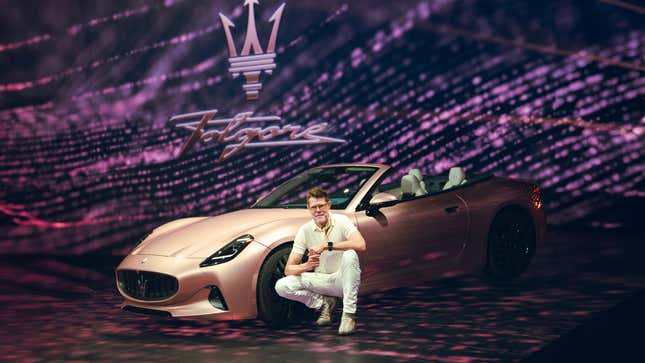
For more than 75 years, Maserati has been designing stunning road cars at its base in Italy, with a team of highly skilled designers and engineers working to create icons like the 3500GT and the MC12. As technology has progressed, the company has moved away from pens and paper, and now uses programming and prompts to see how artificial intelligence could design its next-generation models.
Speaking at the launch of the all-new Maserati GranCabrio electric car, Klaus Busse, head of design at Maserati, explained to Jalopnik that the company has always used cutting edge tech to design its cars. When Busse started out, this meant learning his craft using Vellum paper and powdered crayons to create “smooth” and “soft” cars.
“With the 1954 A6GCS, the reason the car looks the way it is is because they were using the design tools they had at that time,” explains Busse. “Then Canson paper came in, mostly in the ’70s, and those cars were all designed in a side view on this blue paper that you’ve seen.”

In the 1990s and early 2000s, computers began to play an increasingly important role in automotive design, with designers turning to programs like PhotoShop to iterate their countless times. Maserati has now moved on again, and uses artificial intelligence across its design houses.
“AI is basically nothing but a creative tool for us,” says Busse. “I literally can be having an espresso with you and design 50 Maseratis. Or AI can design it for me based on my prompts. I can mix in a few other things, I can train a little bit. I can literally do it while I have an espresso with you.”
However, this doesn’t mean that the new GranCabrio was developed by turning to Dall-E and asking it to “design a Maserati EV.” Instead, tools like AI are about offering a “mirror” that shows a glimpse at the direction Maserati could take, says Busse.
“AI is not really inventing the future,” he says. “We are using AI for certain tools, but I don’t want to think that AI is the solution. It might become it, but it’s not. It’s just another tool and even more than before, it requires extreme ability of self curation.

With tools such as AI at his disposal, Busse believes we are now in the “quantum” age of automotive design. At Maserati, this means that the days are gone when automakers would take countless prototypes down to the wind tunnel to test them out.
“The MCXtrema was the first Maserati ever to be designed only in the computer,” Busse explains. “So there’s no hand modeling, because in this case, speed efficiency, exchange of data, aerodynamics was the key.”
Instead, designers will finalize their plans before sending them off to a modeler to test on complex computer programs. After just a few days, the design team will be presented with feedback on the feasibility of their plans and everything that needs to change to make cars like the GranCabrio a reality. This way, car design has become “super efficient, super fast” Busse adds.

Is this reliance on data good for car design, though? If it’s practices such as this that have led us to cars like the GranCabrio and GranTurismo that Maserati is offering today, then I think I’m all for it. However, if it leads to sterile, overly scientific cars that lack any soul, then we might have gone a step too far.